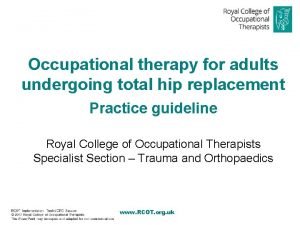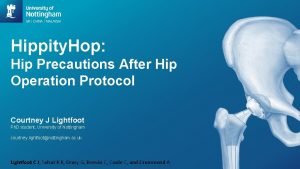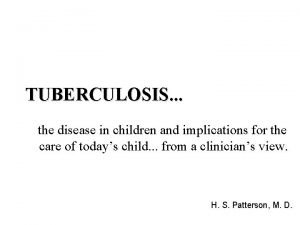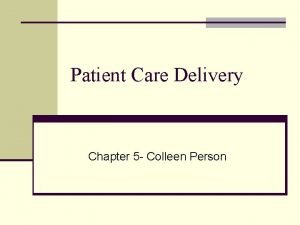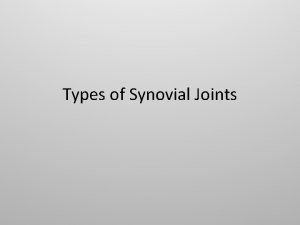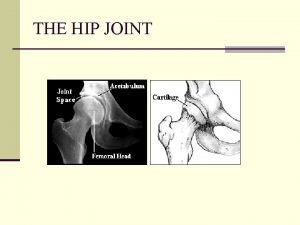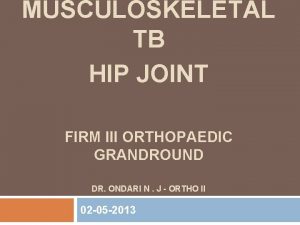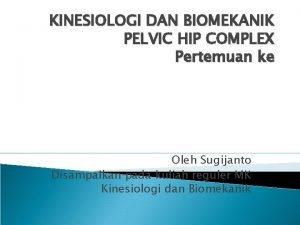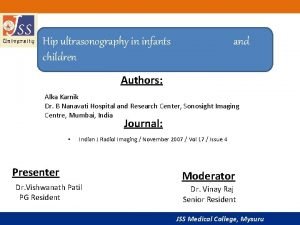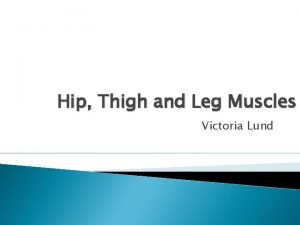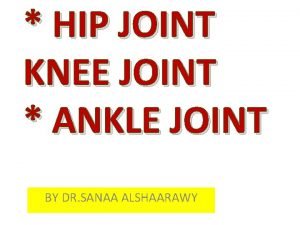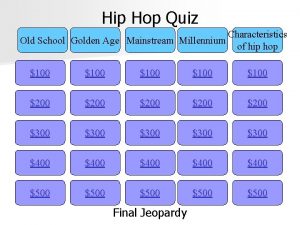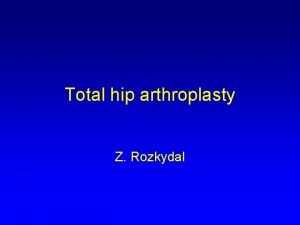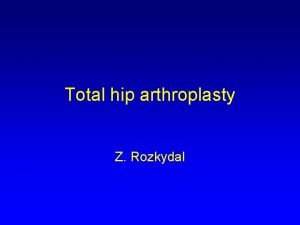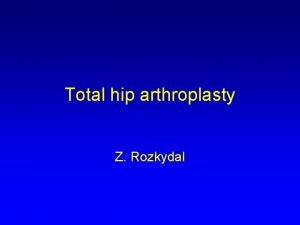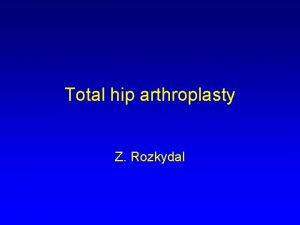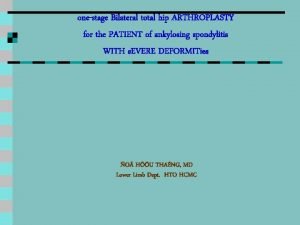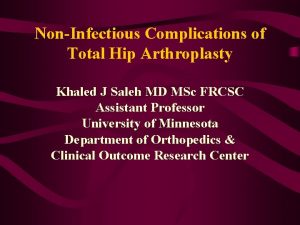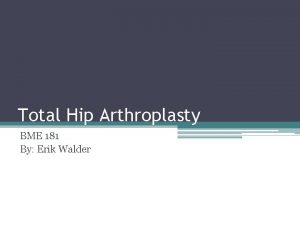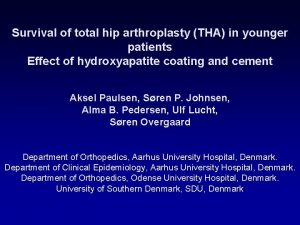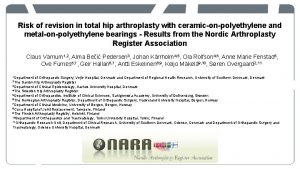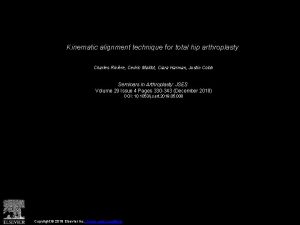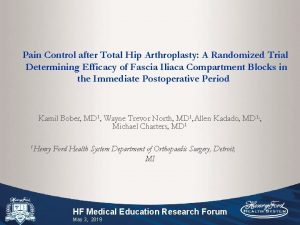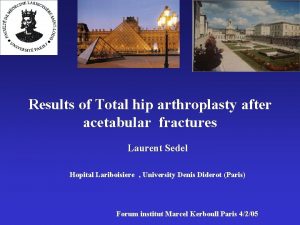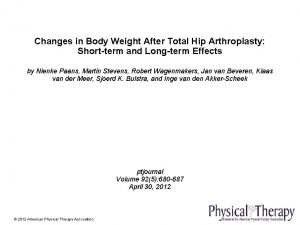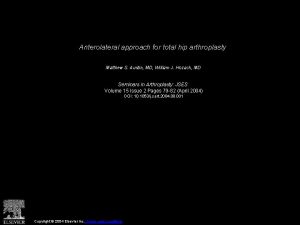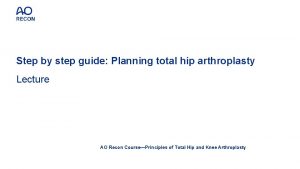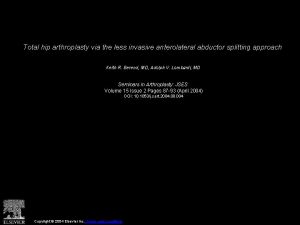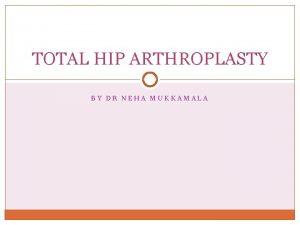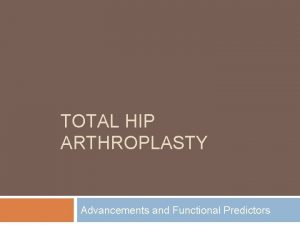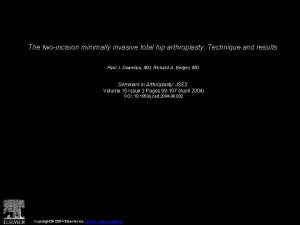Module 3 Complex primary total hip arthroplasty Small

































- Slides: 33

Module 3: Complex primary total hip arthroplasty Small group discussion AO Recon Course—Complex Total Hip and Knee Arthroplasty

Learning objectives • Assess the patient preoperatively • Classify and manage hip dysplasia requiring total hip arthroplasty (THA) • Plan and perform a THA after previous femoral fracture, acetabular fracture, or femoral osteotomy 2

Case 1 3

Case history • A 36 -year-old woman • Left hip pain, greater than right hip pain • Ambulating without the use of aids • Examination: • No apparent leg-length discrepancy • Range of motion in both hips: abduction 15°, flexion 45° • Gluteus medius strength: 5/5 • No previous surgery 5

Imaging 6

Planning • Special laboratory investigations? • Additional imaging needed? 7

Additional imaging 31° 8 42°

Planning • Surgical approach? • Acetabular implant and fixation method? • Femoral implant and fixation method? • How would you achieve leg-length equalization? • How would you reduce complications? 9

Planning 10

Treatment performed • Primary cup and stem • Cemented fixation • Femoral shortening osteotomy 11

Take-home messages • Should have small-diameter cups and stems in inventory • Consider shortening femoral osteotomy if: • Leg lengthening is greater than 4 cm • Maltorsion (excessive anteversion) • Bilateral high-grade dysplasia 12

Case 2 13

Case history • A 70 -year-old man • Car collision 2 years ago with pelvic-acetabular fracture • Associated injury: none • Percutaneous fixation performed • Increasing pain over past 6 months • Uses a walker now 15

Imaging 16

Planning • What other imaging studies would you order? • What laboratory tests would you order? 17

Additional imaging Judet views 18

Additional imaging • What do you see? • What is the type of bone deficiency? Proximal to distal 19

Planning • Cup options? • Stem options? 20

Treatment performed • Cup: cementless fixation, ultraporous with screws, autograft • Stem: cementless fixation, monobloc, tapered, macrotextured 21

Intraoperative laboratory findings • Joint fluid: 1, 200 nucleated cells, 75% polymorphonuclear cells • Cultures: no growth 22

Postoperative imaging • Leg lengths • Cup position 23

Postoperative imaging • Cup coverage by posterior column • Screw into ischium 24

Follow-up • After 6 years postoperative • Ambulating without cane 25

Take-home messages Conversion THA from previous acetabular fracture: • Retained hardware • Possible infection • Acetabular bone deficiency • Prophylaxis against heterotopic ossification 26

Case 3 27

Case history • A 74 -year-old man • Fell from a height of 10 meters • Community ambulator • Lives alone 29

Imaging 30

Initial treatment performed 31

Following initial surgery. . . Fell again at home while going to the bathroom 3 weeks postoperative 32

Planning • What treatment options would you consider now? • What implant designs would you select? 33

Treatment performed • Cementless fixation • Fixation of trochanter fragment with wires 34

Take-home messages • Removal of retained hardware can create additional fractures • Cementless fixation preferred over cemented to optimize fracture healing • Postoperative weight-bearing restriction may be necessary for trochanter fragment healing 35

Module 3: Complex primary total hip arthroplasty Small group discussion
 Occupational therapy intervention plan for hip arthroplasty
Occupational therapy intervention plan for hip arthroplasty Hip hop hip to the hippity
Hip hop hip to the hippity Hip hop hip to the hippity
Hip hop hip to the hippity Arthroplasty practitioner
Arthroplasty practitioner C device module module 1
C device module module 1 Pauline and bruno have a big argument
Pauline and bruno have a big argument Droplet infection
Droplet infection Simple, compound-complex rules
Simple, compound-complex rules The electra complex
The electra complex Freudian ideas
Freudian ideas Type a and type b personality theory
Type a and type b personality theory Activo promedio
Activo promedio Total revenues minus total costs equals
Total revenues minus total costs equals Total revenues minus total costs equals
Total revenues minus total costs equals Total revenues minus total costs equals
Total revenues minus total costs equals Total revenue minus total expenses
Total revenue minus total expenses Primary complex in children
Primary complex in children Primary complex symptoms
Primary complex symptoms Primary nursing vs total patient care
Primary nursing vs total patient care The primary pigments are _____ the primary colors.
The primary pigments are _____ the primary colors. Hip hughes buddhism
Hip hughes buddhism Hip bath benefits
Hip bath benefits Synovial joint meniscus
Synovial joint meniscus Medial rotation of hip muscles
Medial rotation of hip muscles Vertical suspension diagram
Vertical suspension diagram Hip range of motion
Hip range of motion Babcock triangle boundaries
Babcock triangle boundaries Hip hop prezentace
Hip hop prezentace Biomekanik hip joint
Biomekanik hip joint Hip usg
Hip usg Hip thigh and leg muscles
Hip thigh and leg muscles Hip internal rotation goniometry
Hip internal rotation goniometry Lateral rotation of thigh muscles
Lateral rotation of thigh muscles Old school hip hop trivia
Old school hip hop trivia
